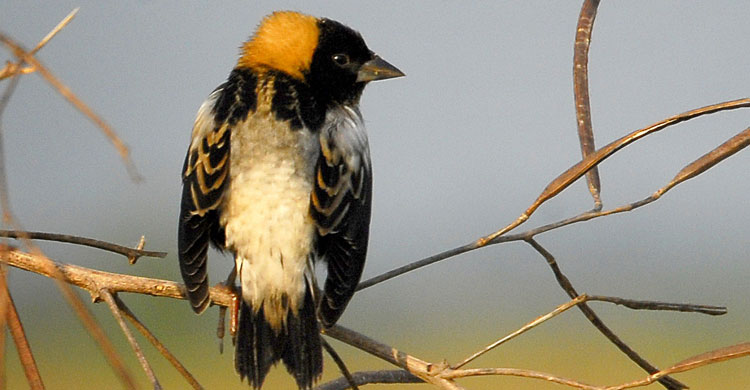Great Boost for Conservation of Grassland Birds and Flyways in the Americas

Male Bobolink © Andrea Westmoreland from DeLand, United States (Bobolink at Lake Woodruff) [CC BY-SA 2.0 (https://creativecommons.org/licenses/by-sa/2.0)], via Wikimedia Commons
Bonn, 31 August 2018 - The Second Meeting of Signatories (MOS2) of the Memorandum of Understanding (MOU) on the Conservation of Southern South American Migratory Grassland Bird Species and their Habitats took place from 24 to 25 July 2018 in the city of Florianópolis, at the kind invitation of the Government of Brazil.
The MOU’s Action Plan was updated until the year 2023 and specific objectives were developed for the protection and sustainable management of grasslands which are of importance to migratory birds and the ecosystem services they provide. A new species of bird, the Bobolink, was added to the list of species under the MOU. The Bobolink was included in CMS appendix II at COP11 in Quito in 2014, at the proposal of Bolivia. A discussion took place about the extension of the MOU range and it was finally decided to maintain the range as it is now, restricted to the Southeast South America (SESA) grasslands. However, it was agreed to invite as observers for future meetings other countries of the Americas where grasslands occur, such as Canada, Colombia, México, Venezuela and the USA.
Two organizations signed the MOU as cooperating partner: the Fundación Vida Silvestre Argentina and the Western Hemisphere Shorebird Reserve Network. It was agreed that Brazil would coordinate the MOU until the next meeting of signatories that will likely take place in Paraguay in 2022.
The South American Grassland Bird MOU was concluded under the auspices of CMS and became into effect on 26 August 2007. Under the Convention on Migratory Species, the governments of Argentina, Bolivia, Paraguay and Uruguay agreed to work together towards better conservation of migratory species of grassland birds of Southern South America and developed the MOU text. Brazil has also signed the MOU.
The grasslands of south-eastern South America, which comprise one of the most extensive grassland ecosystems in the Neo-tropics, have suffered negative impacts from the development of the livestock industry, arable agriculture and forestry. The grasslands have a rich avifauna that includes 22 globally threatened and near-threatened species, and many other species have suffered local population extinctions and range reductions. In addition to habitat loss and fragmentation, grassland birds in these ecosystems are threatened by improper use of agrochemicals, unfavourable fire management regimes, pollution and illegal capture and hunting.
The First Meeting of Signatories (MOS1) of the MOU took place in Asunción, Paraguay, on the 15th of December 2010. At the meeting Signatories adopted an Action Plan for the MOU which focuses on protecting and managing habitats for migratory grassland birds by identifying new protected areas, providing financial incentives to local cattle ranchers, coordinating monitoring and research of grassland biodiversity among countries, conducting threat assessments, raising awareness and enhancing international cooperation towards developing a legal framework for the preservation of grasslands. In addition, it recommends actions to be taken outside of protected areas to help conserve habitat on private land.

Americas Flyways Task Force
Back to back with the grassland birds meeting, the Task Force for the Americas Flyways met for the first time. Thirty participants from North, Central and South America got together to develop a detailed workplan for the Task Force until the next CMS COP in 2020. At the meeting, World Migratory Bird Day was highlighted as the most relevant global campaign dedicated to raising public awareness about migratory birds and their conservation needs. Susan Bonfield (Environment for the Americas (EFTA)) gave a presentation about the history of the campaign and highlighted the fact that the EFTA in the Americas had now joined forces with CMS and AEWA to organize a single global campaign. The new global campaign brings together former International Migratory Bird Day (IMBD) and World Migratory Bird Day and has adopted the latter as the title of the new global awareness-raising campaign for migratory birds.
The US Fish and Wildlife Service, which participated remotely via Skype, announced the release of 29 grants under the Neotropical Bird Act, which provides an opportunity to seek funding for some of the Task Force projects. A small steering group was established to monitor progress in the implementation of the workplan and it was agreed to hold the next meeting in Panama in the fall of 2019.
The Americas Flyways Framework (AFF) Task Force is convened under the mandate provided by Resolution 11.14 on Migratory Birds and Flyways. The resolution calls on the Flyways Working Group and on the CMS Secretariat to support the establishment of a Task Force to coordinate engagement of partners in the development and implementation of an action plan for the AFF including provisions for concerted conservation action for priority species. Relevant hemispheric entities are involved with the aim of reinforcing their mandates.
The goal of the AFF Task Force is to establish a shared and common practice for conservation of migratory birds in the countries of the Americas, strengthening the implementation of already existing initiatives for migratory bird conservation in the Region and promoting cooperation between countries. The Task Force facilitates implementation of the Americas Flyways Framework and associated Action Plan, with a focus on filling gaps and enacting conservation on the ground.
For more information please contact Borja Heredia, Head of the CMS Avian Unit at: [email protected]
Last updated on 18 December 2018








